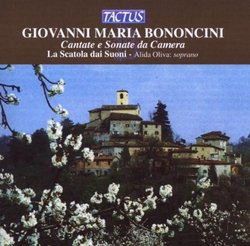| All Artists: Giovanni Maria Bononcini, La Scatola dai Suoni, Alida Oliva Title: Giovanni Maria Bononcini: Cantate e Sonate da Camera Members Wishing: 0 Total Copies: 0 Label: Tactus Records Original Release Date: 1/1/2009 Re-Release Date: 8/11/2009 Album Type: Import Genres: Pop, Classical Styles: Vocal Pop, Chamber Music, Historical Periods, Classical (c.1770-1830) Number of Discs: 1 SwapaCD Credits: 1 UPC: 8007194103977 |
Search - Giovanni Maria Bononcini, La Scatola dai Suoni, Alida Oliva :: Giovanni Maria Bononcini: Cantate e Sonate da Camera
 | Giovanni Maria Bononcini, La Scatola dai Suoni, Alida Oliva Giovanni Maria Bononcini: Cantate e Sonate da Camera Genres: Pop, Classical
The works of Giovanni Maria Bononcini are part of the cultural heritage of the Este dynasty, created to a large extent by the duke Francesco II following the move of the Estense capital from Ferrara to Modena at the end of... more » |
Larger Image |
CD Details
Synopsis
Album Description
The works of Giovanni Maria Bononcini are part of the cultural heritage of the Este dynasty, created to a large extent by the duke Francesco II following the move of the Estense capital from Ferrara to Modena at the end of the 16th century. The so-called "Modenese school," which existed alongside the more celebrated schools of Mantua and Bologna, recognized Marco Uccellini as the founder and great teacher of an entire generation of musicians. His direct disciple, who carried on his work and musical discourse--contrapuntal, formal, and instrumental--was without a doubt Giovanni Maria Bononcini.

 Track Listings (14) - Disc #1
Track Listings (14) - Disc #1